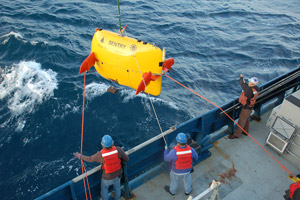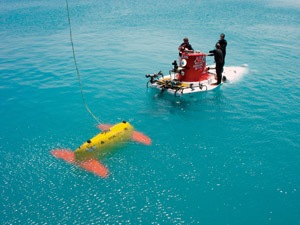|
Expedition 13 Hot Topics: AUV Sentry
Engineers and ship crew deploy and recover the AUV Sentry from the deck of the research vessel Oceanus in April 2008. (Video by Chris German, Woods Hole Oceanographic Institution)
Sentry produces bathymetric and magnetic maps of the seafloor and is capable of taking digital bottom photographs in a variety of deep-sea terrains such as mid-ocean ridges, deep-sea vents, and cold seeps at ocean margins. (Animation by Jack Cook, WHOI)
This animation of a plume of hydrocarbons emanating from the Deepwater Horizon oil spill shows the autonomous underwater vehicle (AUV) Sentry making numerous criss-cross penetrations to map the parameters of the 1,100 meter-deep plume. (Animation by Jack Cook, WHOI) Imagine you could design the perfect robot companion. Something to do the tasks you couldn’t do—or perhaps didn’t want to do. You would want it to be able to carry out your orders without constant supervision. You would also want to be able to trust that it would do what you told it to do, no matter how difficult or repetitive that might be. Now imagine your new friend could dive 3 miles and swim continuously for nearly a day at a time and find underwater volcanoes and hydrothermal vents. You just described the autonomous underwater vehicle (AUV) Sentry. Unlike human-occupied vehicles (HOVs) such as Alvin, it cannot transport scientists to the bottom to view in person the animals that live there or the processes that shape the planet. It also cannot take continuous commands and receive power from the surface like the remotely occupied vehicle (ROV) Jason does. Sentry can, however, survey large areas of the sea floor on dives lasting nearly a day without requiring that someone watch its every move. This is important when the job requires a long series of difficult or repetitive tasks that would be difficult and expensive to do with an ROV or HOV or that would very quickly become monotonous or overwhelming for a human to do manually. On a recent cruise to the Galapagos Rift, Sentry mapped about 100 square kilometers (40 square miles) of the seafloor to a resolution of 1 meter (3 feet), and it never complained once. Following the Scent AUVs “work like bloodhounds,” said WHOI Senior Scientist Dana Yoerger, who teamed with WHOI engineers Al Bradley and Barrie Walden to design Sentry and its predecessor ABE. “When they find something we’re interested in, they can ‘bark’ and then return from the ‘hunt.’ ” Or, as Sentry did on a recent mission in the Gulf of Mexico, it can stay on the hunt and make detailed maps of an underwater chemical plume (see animation) connected to the Deepwater Horizon oil spill. By pairing Sentry with Alvin, scientists can also help make the best use of the HOV’s limited time on the bottom. Sentry will generally do its work at night, before Alvin dives the following morning. The detailed maps that Sentry produces helps scientists and Alvin’s support crew fine-tune the day’s dive plan with much greater precision than before. Now, scientists can actually pinpoint volcanic features or coral reefs on the bottom before diving in the sub to get a closer look for themselves. The Shape of Things to Come The vehicle also has four propeller-like thrusters built into its maneuverable foils, or wings, giving Sentry the ability to start, stop, change directions, and ‘fly’ in different ways underwater. It can even hover like an underwater helicopter to do close-up examinations of the seafloor. Traditional torpedo-shaped AUVs tend to keep moving in one direction. Sentry is designed to dive very deep—as deep as 4,500 meters (3.1 miles)—putting nearly two-thirds of the global ocean within its reach. It is powered by more than 1,000 lithium-ion batteries similar to those in laptop computers, which allow it to dive up to 20 hours without a break. It might mean that scientists have an even larger mountain of data to sift through at the end of the day, but when you’re diving in the deep ocean, more information is often a good thing. Click and drag on the Sentry vehicle for a 360 degree view:
|
Mailing List | Feedback | Glossary | For Teachers | About Us | Contact
© 2010 Dive and Discover™. Dive and Discover™ is a registered trademark of Woods
Hole Oceanographic Institution


